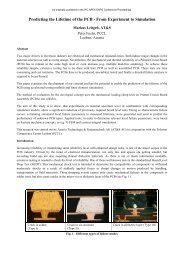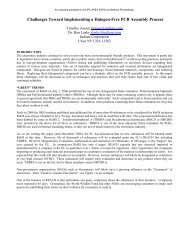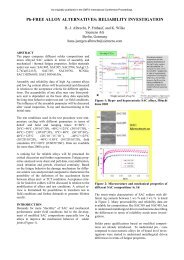Minimizing Voiding In QFN Packages Using Solder ... - IPC Outlook
Minimizing Voiding In QFN Packages Using Solder ... - IPC Outlook
Minimizing Voiding In QFN Packages Using Solder ... - IPC Outlook
You also want an ePaper? Increase the reach of your titles
YUMPU automatically turns print PDFs into web optimized ePapers that Google loves.
As originally published in the <strong>IPC</strong> APEX EXPO Proceedings.PLACEMENT RECOMMENDATIONSFigure 4. Illustration of a rectangular solder preform placed on the solder pasteSince the solder preform is packaged in tape & reel, its placement can be manipulated easily to achieve the desired result. <strong>In</strong>order to ensure there will be sufficient tack to hold the <strong>QFN</strong> component, the preform must be pushed into the paste farenough to allow for the solder paste contact to the <strong>QFN</strong>. (See Fig. 4) If this result isn't achieved, component floating willoccur. <strong>In</strong> addition, it must be assured that the <strong>QFN</strong> leads make good contact to the solder deposit on the lead pads. Thesolder preform placement force is critical, as the preform still needs to be as flat as possible after it is placed into the paste. <strong>In</strong>addition, component placement pressure should be increased to ensure that the component seats well in the paste along theperimeter of the preform.Table 3. Placement pressure in Newton’sPlacement Pressure Placement Pressure PlacementPreform Component Performance2n 2n Poor5n 3n Fair4n 3n Good<strong>In</strong>creased placement pressure on the solder preform can result in its bending. The pick & place nozzle should occupy themost surface area possible on the preform. See Figure 5. The best nozzle will support the preform to preserve flatness.Bending can result in skewing of the <strong>QFN</strong> at reflow.NozzleFigure 5. Illustrates the desired relationship between the nozzle and the solder preformFLUX COATINGThe interface between the top of the solder preform and the thermal pad on the <strong>QFN</strong> does not contain paste; therefore there isno flux to prepare the surface for solder wetting. This shortcoming can also cause excessive voiding. The solution is a fluxcoatedsolder preform. See Figure 6. A solder preform coated with NC-9 flux at 1 to 1.5% by weight, will be sufficient toensure good wetting without incurring voiding.The flux coating must be deemed compatible with the paste used.PreformFlux CoatingFigure 6. To minimize voiding the solder preform must be flux-coated as shown
As originally published in the <strong>IPC</strong> APEX EXPO Proceedings.REFLOW PROFILEWhen adding a solder preform to the process, reflow profile adjustments are not specified or required. <strong>In</strong> cases of low thermalmass, a more linear profile is acceptable, but in cases of high thermal mass, a soak profile is required. The addition of asolder preform has actually been shown to reduce variability from one board to the next and is tolerant of reflow profileadjustments.COLLABORATIVE TESTING OVERVIEW:<strong>In</strong> order to evaluate the effectiveness of solder preforms in minimizing voiding in <strong>QFN</strong>s, a collaborative investigation wasperformed. The critical parameters in this study are listed below:<strong>QFN</strong> thermal pad dimensions (dims): 2mm x 2mmPaste: No-clean solder paste with 89% SAC387, Type 3PWB pad dims: 2mm x 2mmStencil dims: 2mm x 2mm x .004” thickPreform dims: 1.7mm x 1.7mm x .002” thickFlux coating: NC-9 @ 1.0% by weightProfile: SoakThe resulting voiding average was less than 10%, and improvement from the initial voiding average can be as much as 50%or more of the solder joint.<strong>In</strong> Conclusion:As stated, voiding under <strong>QFN</strong>s is attributed to flux entrapment and/or lack of solder in the joint. The addition of a solderpreform dramatically increases the solder content without excessive flux. The additional solder density residing in the centerof the pad also inhibits the development of a large void.To minimize voiding design considerations should include:Stencil Design: manufacturer recommended<strong>Solder</strong> Preform Geometry: approx. 85% thermal pad dimensions and 50% paste thicknessPlacement Parameters: increase placement pressure, muzzle selectionFlux Coating: required for solder preform/<strong>QFN</strong> interfaceReflow Profile: dependent/flexibleAcknowledgment:Portions of this paper were presented at SMTAI 2011, Fort Worth TX.i Herron, D, Liu, Y, and Lee, N.C., <strong>Voiding</strong> Control At <strong>QFN</strong> Assembly, SMTAI, Forth Worth, TX, 2011.
As originally published in the <strong>IPC</strong> APEX EXPO Proceedings.<strong>QFN</strong>s are in DemandPrismark projects that by 2013, 32.6 billion <strong>QFN</strong>s will be assembled .• Smaller form factors• <strong>In</strong>creased demand on performance
As originally published in the <strong>IPC</strong> APEX EXPO Proceedings.“The Challenge”• Paste is approx. 50% flux by volume• Low stand-off leaves no exit for excess volatiles• Large voiding causes near term failure or long-term reliabilityrisk
As originally published in the <strong>IPC</strong> APEX EXPO Proceedings.Parameters to be Discussed• Stencil/pad design• Preform geometry• Placement parameters• Preform flux coating• Reflow profile©INDIUMCORPORATION
As originally published in the <strong>IPC</strong> APEX EXPO Proceedings.Thermal Pad Design
As originally published in the <strong>IPC</strong> APEX EXPO Proceedings.Printed Paste on the Board
As originally published in the <strong>IPC</strong> APEX EXPO Proceedings.Can Process Changes Work?• Herron etal 1 showed anumber of trends:– “Window paning” createsvents that results insmaller voids– Vent channels resulted inadditional “open” areasthat reduced solder jointcontinuity1. Herron, D, Liu, Y, and Lee, N.C., <strong>Voiding</strong> Control At<strong>QFN</strong> Assembly, SMTAI, Forth Worth, TX, 2011
As originally published in the <strong>IPC</strong> APEX EXPO Proceedings.Can Process Changes Work?• Plating thermal vias with solderable material minimizesvoiding• Even with venting and an optimum process, it is difficultto reduce voiding below 30% and, in some cases, 40%.• <strong>In</strong> cases where voiding must be below 20%, solderpreforms will likely be required.
4tion requirements, and inadequate protections for intellectual property(IP), among other barriers to free trade.The United States government uses a combination of diplomacyand enforcement tools to try to address China’s unfair practices,but despite these efforts, Chinese trade violations continue and thebilateral trading relationship grows more lopsided. Unfortunately,the United States too often chooses dialogue with China overstrong enforcement measures, and bilateral talks often fail to delivermuch more than an expanding menu of follow-on discussions.And although the Obama Administration has significantly steppedup trade enforcement cases against China, these efforts are limitedin their impact because defendants continue to rely on an array ofloopholes for avoiding trade remedies.An even bigger challenge for enforcement efforts looms ahead. <strong>In</strong>December 2016, the provision of China’s WTO accession protocolthat enables countries to treat China automatically as a non-marketeconomy expires. The expiration of this WTO provision may potentiallymake it more difficult for the United States to levy penaltytariffs against China for dumping. This does not mean that theUnited States will have to recognize China as a market economy.The existing statutory test under U.S. law will still apply for purposesof determining China’s status, and multiple subject matterexperts testified to the Commission that China is far from meetingthe criteria.As dialogue and enforcement efforts fall short, a rapidly expandingstream of Chinese direct investment is flowing into the UnitedStates. This trend could be a boon to U.S. employment if the investmentsprove to be engines for job creation. However, the presenceof Chinese state-owned enterprises in the United States mayalso pose significant competitive challenges for domestic companies,with potentially serious drawbacks for U.S. workers. Chinese investmentin the United States could also create impediments fordomestic industries petitioning the federal government for tradeenforcement assistance, and anecdotal evidence demonstrates thatstate efforts to attract Chinese investment can undermine federaltrade enforcement measures as well.Conclusions• The United States’ trade deficit with China is by far its largest,and it has grown sharply in recent years to become thesingle biggest bilateral deficit in the world. <strong>In</strong> 2013, it reached$318.4 billion, setting a record for the fourth straight year,with China exporting nearly four dollars’ worth of goods to theUnited States for every dollar’s worth of imports it purchasedfrom the United States. Even as U.S. exports to China havegrown, our deficit has grown faster. This deficit is associatedwith declining U.S. economic competitiveness and job losses,which helps explain why 52 percent of Americans now believethat China poses a critical threat to vital future U.S. economicinterests.• U.S. employment in some sectors, particularly the manufacturingsector, has dropped substantially as trade with Chinahas increased. Since China joined the World Trade Organiza-DSK7XT4K02 with $$_JOBVerDate Mar 15 2010 13:44 Nov 05, 2014 Jkt 000000 PO 00000 Frm 00016 Fmt 6633 Sfmt 6633 G:\GSDD\USCC\2014\FINAL\88483.XXX 88483
As originally published in the <strong>IPC</strong> APEX EXPO Proceedings.Preform dimensions*80% of the <strong>QFN</strong> ground pad area is a good place to start.Preform design:<strong>QFN</strong>4 x 4 9 x 9Thermal Pad2.15 x 2.15 7.25 x 7.25Preform1.83 x 1.83 6.16 x 6.16.002” .002"
As originally published in the <strong>IPC</strong> APEX EXPO Proceedings.Preform vs. Printed PasteThicknessThe preform thickness should be approximately50-70% of the printed paste thicknessPCBPreformPaste
As originally published in the <strong>IPC</strong> APEX EXPO Proceedings.Why Flux Coated?<strong>QFN</strong>PREFORMFluxCoatingPCB• Flux coating provides flux at the interface with the padon the <strong>QFN</strong>• Will not contribute to voiding• Promotes wetting, discouraging void propagation
As originally published in the <strong>IPC</strong> APEX EXPO Proceedings.Why Flux Coated?<strong>QFN</strong><strong>QFN</strong>4 x 4 9 x 9Thermal Pad2.15 x 2.15 7.25 x 7.25Preform1.83 x 1.83 6.16 x 6.16Alloy: SAC305 with 1.5% by weight flux coating1.83mm x 1.83mm x .05mmPreform wgt: .0012gmsFlux wgt: .000018gms6.16mm x 6.16mm x .05mmPreform wgt: .0141gmsFlux wgt: .0002gms.002” .002"
As originally published in the <strong>IPC</strong> APEX EXPO Proceedings.Some Considerations• Experimentation was done using a no-clean pastein conjunction with a no-clean flux-coated preform.• A preform without flux coating in conjunction withthe no-clean paste did show better results but notas repeatable.• If a water-wash paste is used, a preform withoutflux can still be placed but results are not know atthis time.
As originally published in the <strong>IPC</strong> APEX EXPO Proceedings.Pick and Place ParametersTape selection: pocket dimensions must be adjusted to minimize travel inthe pocket while in transport and on the line. This will minimize mis-picks.• Pitch• Depth of pocket• Cover tape
As originally published in the <strong>IPC</strong> APEX EXPO Proceedings.Preform FlatnessPlacement Pressure Placement Pressure PlacementPreform Component Performance2n 2n Poor5n 3n Fair4n 3n Good<strong>In</strong>chesPaste thickness 0.004Preform thickness -0.002Std Tolerance +/- -0.001Clearanc0.001e
As originally published in the <strong>IPC</strong> APEX EXPO Proceedings.Reflow Profile Adjustments• When a preform is used, the reflow profileshould reflect a ramp to peak.• This is not always possible as thermal massof the assembly might require a soak.• When introducing the preform, start with yourexisting reflow profile and adjust as needed.
As originally published in the <strong>IPC</strong> APEX EXPO Proceedings.Breaking Up the “Large” Void• Molten solder density is2x the paste• Wetting force givesdirection to the volatiles• Promotes out-gassing
As originally published in the <strong>IPC</strong> APEX EXPO Proceedings.Overview• Printed paste should occupy the entire groundpad on full pad design• 80% of the <strong>QFN</strong> ground pad area is a good placeto start• The perimeter of the preform will be paste,providing tack for the <strong>QFN</strong>• Preform thickness 50%-70% of the printed pastethickness• No-clean flux @ 1.5% by wt.• No-clean flux compatibility is a requirement• Placement parameters for high volume production• Adjust reflow profile as necessary.
As originally published in the <strong>IPC</strong> APEX EXPO Proceedings.Collaborative Testing• <strong>QFN</strong> thermal pad dimensions (dims): 2mm x 2mm• Paste: No-clean solder paste with 89% SAC305, Type 3• PWB pad dims: 2mm x 2mm• Stencil dims: 2mm x 2mm x .004” thick• Preform alloy: SAC305• Preform dims: 1.7mm x 1.7mm x .002” thick• Flux coating: No-clean flux @ 1.5% by weight• Profile: Adjusted soakThe resulting void average was reduced by over 50%.
As originally published in the <strong>IPC</strong> APEX EXPO Proceedings.ConclusionsThe addition of flux-coated preforms to your process:• Reduces overall voiding• Prevents creation of a large void• Can be used in high volume processes via tape& reel• Can be customized for process variability
As originally published in the <strong>IPC</strong> APEX EXPO Proceedings.Questions?Thank You!Seth J. HomerProduct Specialist<strong>In</strong>dium CorporationOffice: 315-853-4900Mobile: 315-351-6660shomer@indium.comRonald C. Lasky, Ph.D., PE<strong>In</strong>structional Professor, ThayerSchool of Engineering, DartmouthCollegeSenior Technologist, <strong>In</strong>diumCorporationMobile: 508 930 2242©INDIUM CORPORATION
















